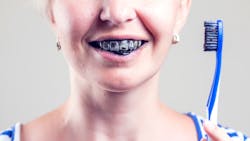"The 6 list" is a feature exploring various topics on oral health, curated for both patients and dental professionals to share with their patients. "6 at-home dental trends to avoid" was medically reviewed by David R. Rice, DDS, chief editor of DentistryIQ.
Social media has given rise untold trends over the years, both good and bad. Among the decidedly questionable is the uptick in DIY dentistry, particularly since the start of the COVID-19 pandemic.
Here are six home dental practices that range from probably not effective to downright dangerous.
1. Using DIY dentures
A quick Google search on DIY dentures will pull up websites touting assemble-at-home dentures as affordable alternatives to the real deal. But this is one case where you get what you pay for: the cheap materials used in homemade dentures make them an esthetic mishap; worse, they can impede chewing and cause pain in the mouth and jaw.
2. Straightening your teeth
Rubber bands, dental floss, fishing line, paper clips—they all have their purpose, but that purpose isn't straightening your teeth. Why not? Because dentists use a very precise amount of force, in very precise locations to move your teeth through your bone. Trying to achieve this yourself can result in teeth breaking, gum damage, and even tooth loss.
6 ways oral health impacts overall health
3. Using charcoal as a whitener
A charcoal and baking soda combination has gained popularity as an effective at-home whitener, but dentists don’t understand why: there is no evidence that shows charcoal is effective, let alone safe for the teeth.
4. Filing teeth to reshape them
Early on in the pandemic, filing teeth was among the dental trends popular on TikTok, with one poster saying “A lot of people started cutting their own hair, I became my own dentist” about the practice. Teeth-filing is dangerous in ways those thinking of doing it might not realize: grinding down the enamel and alters tooth structure, making it easier for cavities and nerve damage to develop.
5. Whitening with Magic Eraser
Briefly rubbing a sponge over the teeth to whiten them sounds harmless enough, right? Wrong—Magic Eraser-type sponges are made from Melamine foam, which contains chemicals that become abrasive when wet. If you have any remaining doubts about the practice, just read a Magic Eraser box. The health and safety warning reads, “Do not use on skin or other parts of the body”—including the teeth.
6. “Oil pulling” for oral health
The practice of oil pulling—swishing oil in the mouth to remove bacteria or whiten teeth—is no social media trend; it’s been around since ancient times. And unlike some of the more recent trends, there’s little actual danger to the practice. But there may also be little point: According to the American Dental Association (ADA), currently there are no reliable scientific studies to show that oil pulling reduces cavities, whitens teeth, or improves oral health and well-being.
About the Author
Elizabeth S. Leaver
Digital content manager
Elizabeth S. Leaver was the digital content manager for Endeavor Business Media's dental group from 2021-2024. She has a degree in journalism from Northeastern University in Boston and many years of experience working in niche industries specializing in creating content, editing, content marketing, and publishing digital and magazine content. She lives in the Boston area.
